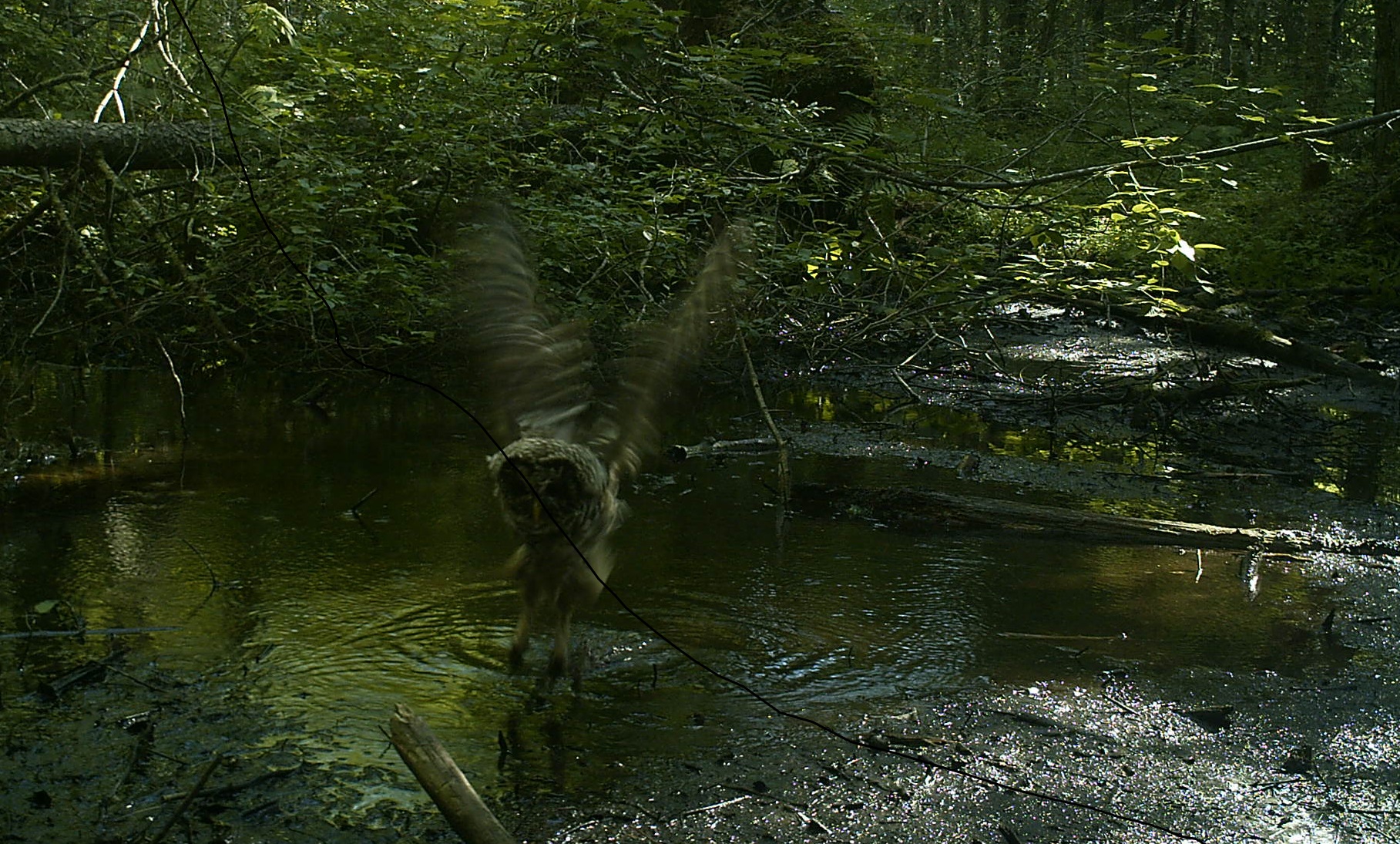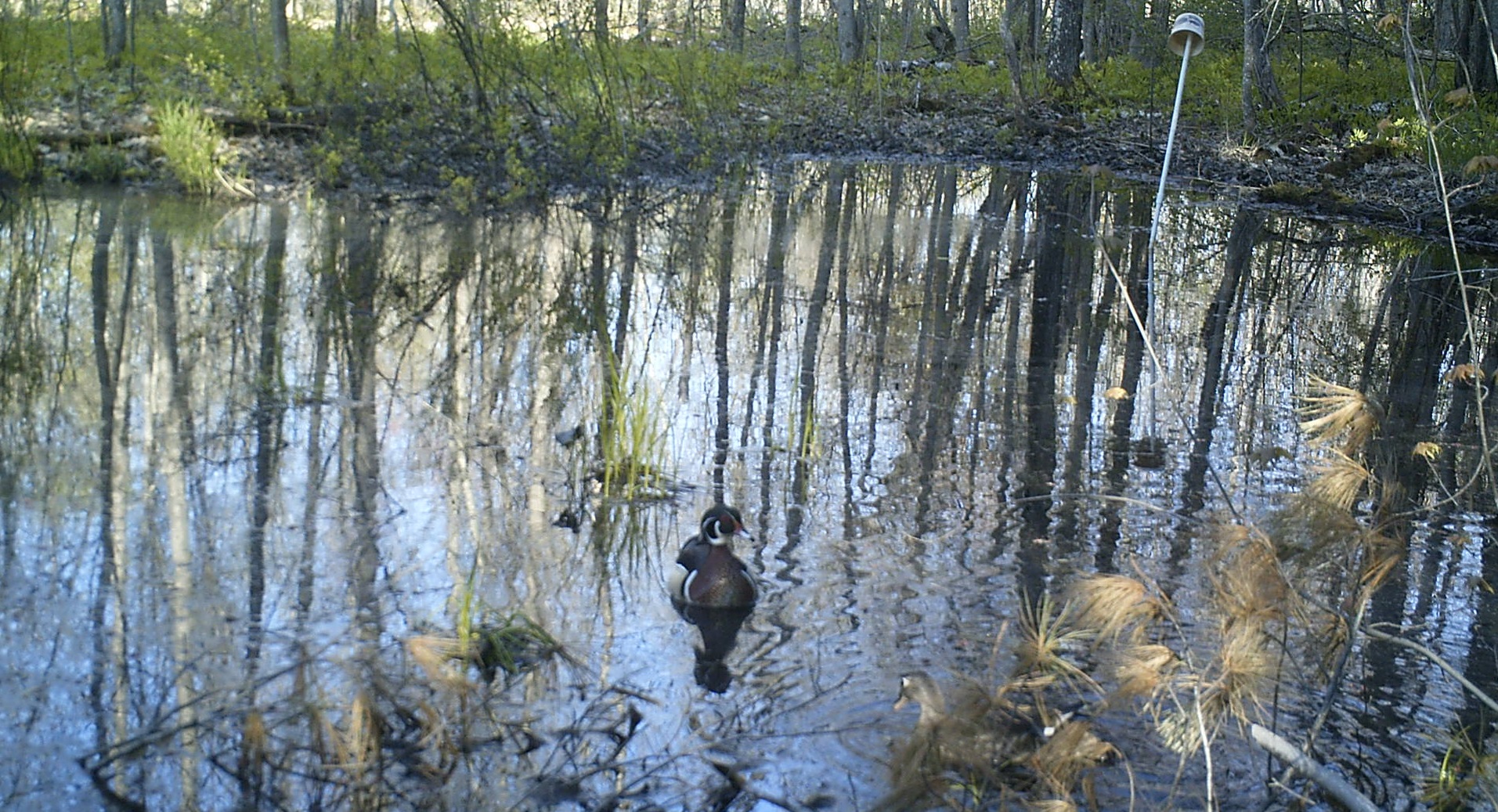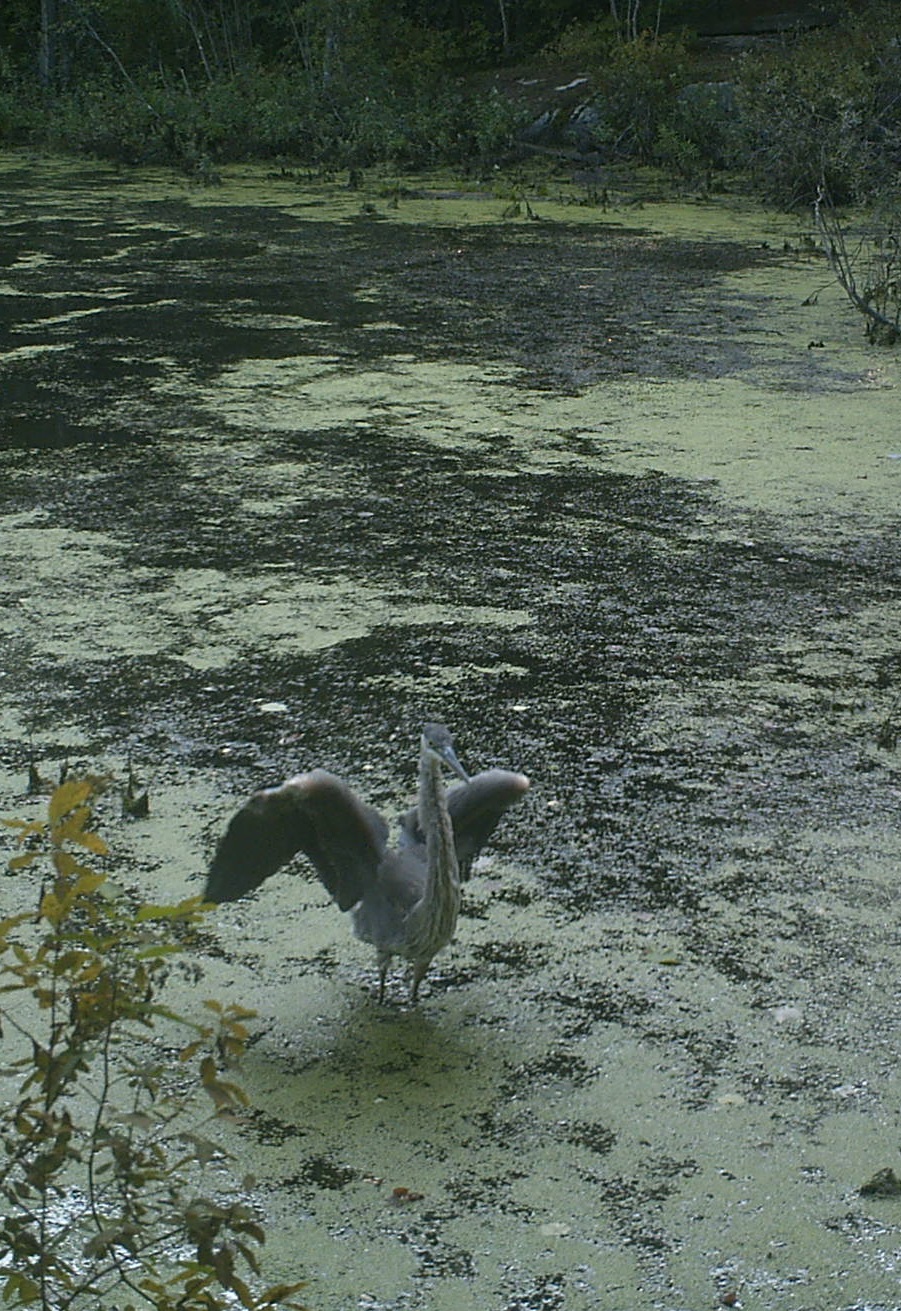
A Barred Owl skims the surface of a vernal pool. Perhaps this owl caught a meal from the pool. Photo credit: Pools and People Trail Camera
Samantha Mpcgarrigle, Undergraduate Research Assistant, University of Maine; Department of Wildlife, Fisheries, and Conservation Biology; Undergraduate, Unity College
Carly Eakin, PhD Researcher, University of Maine; Department of Wildlife, Fisheries, and Conservation Biology
Vernal pools are well known to be the spring breeding grounds and summer nurseries for amphibians such as Wood Frogs (Lithobates sylvaticus) and Spotted Salamanders (Ambystoma maculatum). Much vernal pool conservation is focused on these fun and fascinating amphibians, but vernal pools do more than cater to and conserve amphibians; they are also likely important to birds!

A pair of Wood Ducks dabble in a vernal pool. The colorful male is at the center of the photo and the somewhat drabber female is partly obscured by a pine bough at the lower right corner of the photo. Photo credit: Pools and People Trail Camera
Birds can be important in vernal pool ecosystems as seed dispersers, prey species, and predators. Vernal pools may provide birds with resources in areas that may otherwise be subpar habitat. Some birds are capable of making use of the patchwork urban environment where green areas and pools are fragmented by roads, parking lots, and buildings. Understanding why birds use different areas and resources is going to become more critical as urbanization continues to increase with human population.
While I worked on a vernal pool amphibian study in 2014 several questions about birds at vernal pools started rolling around in my head: Do all vernal pools across a gradient of urbanization provide the same resources for birds? Are some vernal pools better for birds? Are more bird species present at some pools? Why? I decided to explore these questions myself after searching scientific literature did not yield the answers. With some help from folks at the University of Maine and Unity College, in 2015 I started a study to examine vernal pool bird communities across a gradient of urbanization.

A Mallard floats on a vernal pool during a rainstorm. Mallard ducklings were observed at several pools near urban areas. Photo credit: Pools and People Trail Camera
I selected 15 vernal pools with varying levels of urbanization throughout the greater Bangor area and began my study in June. To track which bird species visited the pools throughout the summer, I conducted point counts once per week at each pool. During each point count I stood 3-5 meters from the pool then recorded all birds I heard or saw within 50 meters of the pool. I measured several site characteristics which could influence birds and could provide a more complete picture of the environment available to birds at vernal pools.
Measured Site Characteristics:
- Percentage of impervious land cover (e.g., roads, sidewalks, roofs) within 990 meters of a pool.
- Percent cover of vegetation in and around a pool.
- Water quality – ten parameters such as pH, dissolved oxygen, and chlorine
I observed a total of 50 bird species. American Crow (Corvus brachyrhynchos) and Black-capped Chickadee (Poecile atricapillus) was found at every site, but that was not really a surprise. Crows and Chickadees are fairly common in the region, and they tend to utilize every part of their surroundings. The next two most frequently seen species were Black-and-White Warbler (Mniotilta varia) and Northern Cardinal (Cardinalis cardinalis). In general, the most common species observed at the vernal pools would be considered habitat generalists. Habitat generalists are species that are found in many different environments because they are capable of using a wide variety of resources.

An American Crow struts the banks of a pool. Additional photos taken by our motion-sensor trail camera show this crow scratching through the fallen leaves. Photo credit: Pools and People Trail Camera
I then used linear modeling to examine the influence of water quality, vegetation, and impervious cover on the number of bird species present at a pool (i.e., species richness). The vegetation within the vernal pools had the most influence over the species richness; however, impervious cover was also one of the variables that most influenced the number of bird species. At first I was a bit surprised to find that more species were detected at pools surrounded by more impervious cover. Does urbanization not deteriorate habitat? Is urbanization somehow beneficial for birds at vernal pools? It turns out there is a little more to this story than meets the eye.

A Great Blue Heron stretches its wings for our trail camera. Since fish do not live in these pools if the heron is searching for a meal perhaps bugs or amphibians are on the menu! Photo credit: Pools and People Trail Camera
Although many species were present at the urban pools, these were typically those generalists which can easily live in many places. In fact, some species (e.g., House Sparrow) thrive in human environments. From taking advantage of new available nesting areas to eating food scraps and trash, several birds are utilizing the human-altered environments. This pattern has been observed by others. Other researchers have found urbanized landscapes can support a greater diversity of birds and that higher species richness may not signal a higher quality environment. Specialists (the rough opposite of generalists) are the birds that need a more specific set of criteria to be met. The presence of these birds are more likely to indicate higher quality habitat, thus they typically are of more interest to conservationists.
Although my initial analyses addressed my questions about the impacts of urbanization on birds in vernal pools, these answers only led to more questions about how the composition of the bird community affects ecological functions and conservation priorities for vernal pools. The next phase of my analysis will include a more nuanced look at the balance of generalists and specialists across the urbanization gradient. Although distinctions need to be made about the species composition of bird communities using vernal pools at various levels of urbanization, there is no doubt that birds are a ubiquitous part of the vernal pool ecosystem and should be considered when vernal pool conservation is discussed.
